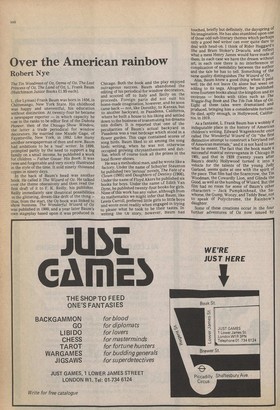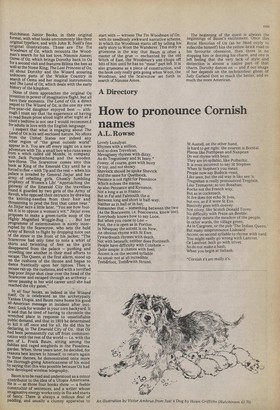Over the American rainbow
Robert Nye
The Tin Woodman of Oz, Ozma of Oz, The Lost Princess of Oz, The Land of Oz, L. Frank Baum (Hutchinson Junior Books £1.95 each).
L. (for Lyman) Frank Baum was born in 1856, in Chittenango, New York State. His childhood was happy and uneventful, his education without distinction. At twenty-four he became a newspaper reporter — in which capacity he rose in the ranks to be editor first of the Dakota Pioneer, then of the Chicago Show Window, the latter a trade periodical for window decorators. He married one Maude Gage. of Fayetteville, New York, in 1882. Like many another newspaperman of then and now, Baum had ambitions to be a 'real writer. In 1899, prompted partly by the need to support a big family on a small income, he published a work for children — Father Goose: His Book. It was twee and forgettable and very nicely illustrated in the style of the time. It sold ninety thousand copies in ninety days.
In the back of Baum's head was another book. He called it The Wizard of Oz. He talked over the theme obsessively and then read the first draft of it to F. K. Reilly, his publisher. Reilly immediately saw theatrical possibilities in the glittering, dream-like drift of the thing — thus, from the start, the Oz book was linked to show business. The Wonderful Wizard ot Oz was published in 1900, and a year later Baum's own stageplay based upon it was produced in
Chicago. Both the book and the play enjoyed outrageous success. Baum abandoned the editing of his periodical for window decorators, and scooted off to Italy and Sicily on the proceeds. Foreign parts did not suit his home-made imagination, however, and he soon came back — not, like Dorothy, to Kansas, but to another backyard, in Pasadena, California, where he built a house to his liking and settled down to the business of transmuting his dreams into dollars. It is reported that one of the peculiarities of Baum's actual backyard in Pasadena was a vast birdcage which stood in a flower garden. This cage contained scores of song birds. Baum liked to sit among the song birds writing, when he was not otherwise occupied growing chrysanthemums and dahlias, which of course took all the prizes in the local flower-shows.
He was a methodical man, and he wrote like a factory. Under the name of Schuyler Staunton he published two 'serious' novels, The Fate of a Clown (1905) and Daughters of Destiny (1906). Under the name of Floyd Akers he published six books for boys. Under the name a Edith Van Dyne, he published twenty-four books for girls. None of this work has any value, although from its mathematics we might infer that Baum, like Lewis Carroll, preferred little girls to little boys and wrote most readily when engaged in trying to please what he took to be their tastes. In writing the Oz story, however, Baum had
touched, briefly but definitely, the dayspring of his imagination. He has also stumbled upon one of those odd sub-literary themes which perhaps
only a good bad writer can ever quite dare to deal with head-on. I think of Rider Haggard 's She and Bram Stoker's Dracula, and reflect what a mess Henry James would have made of them. In each case we have the dream without art, in each case there is no interference or complication of sensibility between the author and the tale he has to tell. Something of the same quality distinguishes The Wizard of Oz. Alas, Baum knew a good thing when it paid well. He did not leave Oz alone but went on adding to its saga. Altogether, he published some fourteen books about the kingdom and its environs — books with titles such as The Woggle-Bug Book and The Tik-Tok Man of Oz. Eight of these tales were dramatised and produced, bringing him a considerable fortune. He died, aptly enough, in Hollywood, California, in 1919.
As a fantasist, L Frank Baum has a wobbly if indisputable place in the history of American children's writing. Edward Wagenknecht once called The Wonderful Wizard of Oz "the first distinctive attempt to construct a fairyland out of American materials," and it is not hard to see. what he meant. The fact that the book made a successful musical extravaganza in Chicago in 1901, and that in 1939 (twenty years after Baum's death) Hollywood turned it into a vehicle for the talents of the young Judy Garland, seems quite at one with the spirit of the piece. That film had the Scarecrow, the Tin Woodman, the Cowardly Lion, and Glinda the Good, as well as the humbug of Wizard. But the film had no room for some of -Baum's other characters — Jack Pumpkinhead, the Sawhorse, the Gump, Woozy, and Teddy Bear, not to speak of Polychrome, the Rainbow's daughter.
Some of these creations occur in the four further adventures of Oz now issued by
Hutchinson Junior Books, in their original format, with what looks uncommonly like their original typeface, and with John R. Neill's fine original illustrations. These are The Tin Woodman of Oz, which recounts the Woodman's search for his lost love, Nimmie Aimee; Ozma of Oz, which brings Dorothy back to Oz for a second visit and features Billina the hen as well as the Nome King; The Lost Princess of Oz, all about Dorothy and the Wizard scouring unknown parts of the Winkie Country in search of Ozma and her magical instruments; and The Land of Oz, which deals with the early history of the kingdom.
None of them approaches the original Oz invention in power of imaginative flight, but all have their moments. The Land of Oz, a direct sequel to The Wizard of Oz, is the one my own five-year-old daughter enjoyed best — although I must say that the experience of having to read Baum prose aloud night after night at a Child's bedtime is not one I would recommend for adults in love with the English language. I suspect that what is engaging about The Land of Oz is its self-enclosed nature. No idiots from the United States nor indeed any other region of "the great outside world" appear in it. You are off every night on a new adventure with Tip, a small boy who runs away from a witch called old Mombi, in company with Jack Pumpkinhead and the wooden Saw-Horse. The Scarecrow comes into this book as King of the Emerald City until he is forced to flee — with Tip and the rest — when his palace is invaded by General Jinjur and her army of rebelling girls. Ghastly fumbling prophecy of Women's Lib! "Approaching the gateway of the Emerald City the travellers found it guarded by two girls of the Army of Revolt, who opposed their entrance by drawing the knitting-needles from their hair and threatening to prod the first that came near." As Jinjur says a little later, "You see how foolish it is to oppose a woman's wit." Jinjur even Proposes to make a green-turtle soup of the Highly Magnified Woggle-Bug . . . But her programme of extermination is nicely interrupted by the Scarecrow, who sets the bold Army of Revolt to flight by dropping mice out of the straw in the front of his jacket: "The Scarecrow had only time to note a whirl of skirts and twinkling of feet as the girls disappeared from the palace — pushing and crowding one another in their mad efforts to escape. The Queen, at the first alarm, stood up on the cushions of the throne and began to dance frantically upon her tiptoes. Then a mouse ran upthe cushions, and with a terrified leap poor Jinjur shot clear over the head of the Scarecrow and escaped through an archway — never pausing in her wild career until she had reached the city gates."
In all four books, as indeed in the Wizard itself, Oz is celebrated as the archetypally Yankee Utopia, and Baum rams home his good all-American message in incident after incident: Look for wonder in your own backyard. It is said that he tired of having to chronicle the wretched place in response to unsatisfiable public demand, and that in 1910 he determined to kill it off once and for all. He did this by declaring, in The Emerald City of Oz, that Oz had been permanently cut off from communication with the rest of the world — i.e. with the pen of L. Frank Baum, sitting among the dahlias and caged songbirds in the Pasadena garden. When, three years later, he decided, for reasons best known to himself, to return again to these themes, he demonstrated once more the thorough-going Americanness of his mind by saying that this was possible because Oz had now developed wireless telegraphy.
Baum is to be read and understood as a minor contributor to the idea of a Utopia Americana. He is — as those four books show — a feeble constructor of sentences, and a writer whose imaginative energy works only in fits and starts of fancy. There is always a tedious deal of padding, and usually a clumsy apparatus to
start with — witness The Tin Woodman of Oz, with its needlessly awkward narrative scheme, in which the Woodman starts off by telling his early story to Woot the Wanderer. This story is gruesome in the way that Baum is often a master of the grue — enchanted by the old Witch of East, the Woodman's axe chops off bits of him until he has no "meat" part left. It is also gruesome as a piece of construction, and the book only really gets going when Woot, the Woodman, and the Scarecrow set forth in search of Nimmie Amee.
The beginning of the ouest is always the beginnings of Baum's excitement. Once this Royal Historian of Oz (as he liked coyly to subscribe himself) hits the yellow-brick road to his favourite obsession, then there is no stopping him or denying his charm, and one is left feeling that the very lack of style and distinction is almost a native part of that charm. Dorothy dances on — and if our image of her depends on the technicolour ghost of Judy Garland then so much the better, and so much the more American.



































































 Previous page
Previous page